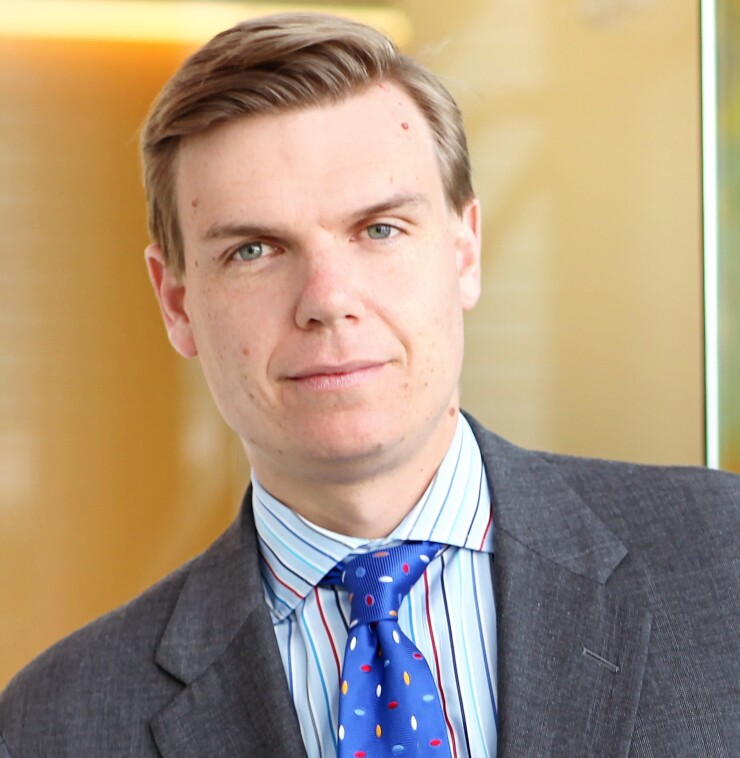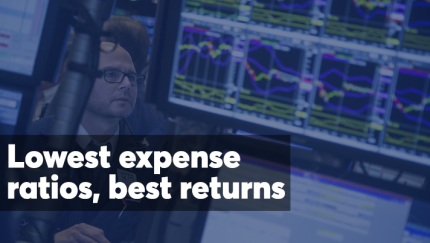Rapid developments in financial technology are top-of-mind for asset managers pondering the industry's top operational challenges.
Money Management Executive reached out to various executives for their takes on how to adapt.
Kestra Financial COO Kris Chester says firms that only provide proprietary technology solutions will find it difficult "to quickly build new and innovative solutions" in a fast-evolving environment, suggesting open-architecture platforms as a solution.

DoubleLine Funds President Ron Redell predicts the strongest managers "will forge ever-closer linkages with the growing array of systematic investment products, open-architecture vehicles and new technologies such as artificial intelligence and predictive analytics."
PNC exec Alex Overstrom says firms must "be careful to avoid a focus on innovation simply for its own sake."
Here’s what Chester, Redell, Overstrom and three other executives foresee.

Polen Capital Information Technology Director Andrew Powers: Shifting to the cloud
The benefits of virtualization and subsequent proliferation of cloud-hosting capabilities have been transformative. Businesses of all sizes can obtain availability and access controls that were previously only available to enterprises. The subsequent reallocation of resources to value-added activities in support of firm goals has been a follow-on benefit.
The challenge that arises, versus on-premise hosting of critical business applications, centers around data governance and integrated reporting. When the firm's data assets are local, control and access to the data is taken for granted. When this data is remote, and often only accessible through limited interfaces, it can become a challenge to manage and use the data properly.
To address this challenge requires a reassessment of the firm's approach to data management. On-premise systems allow data requirements to be partially fulfilled by direct connections to source systems. Databases or data warehouses will need to be redesigned to store source data that is now remotely accessible. In the best-case scenario, the firm can leverage offerings from the cloud/outsourcing provider, such as data marts and APIs, to automatically feed these new data stores.
-
The industry is imagining more vibrant, more agile and more inclusive processes that deliver results, says Confluence CEO Mark Evans.
July 16 -
United Capital’s Mike Capelle on the principles that guided the formation of the firm.
July 14 -
The firm’s investment in Beacon Platform will be used to deliver quantitative research tools to its 240 portfolio managers globally.
May 14
In terms of data governance, the cloud shift allows firms to redesign or affirm the ownership/stewardship of the data, and achieve consensus on taxonomy. The result can be applied consistently and be used to construct meaningful validation and reconciliation routines. Automation is important in this phase, to insure accuracy in the result.
The ultimate payoff is in the implementation of modern reporting tools against the new or redesigned database. These business intelligence platforms can significantly increase reporting agility, allowing mass customization of relevant visualizations. The effort also lays the groundwork to implement modern algorithms to support AI and machine learning.

Kestra Financial Chief Operating Officer Kris Chester: Embracing open platforms
There's currently a disparity of technology adoption between baby boomer advisors and Gen X and Gen Y advisors.
Boomer advisors, while highly successful and independent, are generally more hesitant to adopt integrated and advanced technological solutions that help streamline their business operations and enhance their client experience.
Conversely, Gen X and Gen Y advisors are more apt to implement new technologies. A digitized client experience will not only simplify and streamline client interactions, but will also offer back-office efficiencies that will give advisors and their staff more time to focus on building client relationships.
However, the speed at which technology continues to evolve presents a real operational challenge to firms that provide only proprietary technology solutions. This is because it can be difficult to quickly build new and innovative solutions in a closed environment.
An open architecture platform allows providers to quickly incorporate new technologies into their platform. It's easier to partner with premier software applications and then integrate them into the platform, taking advantage of innovation before it becomes stale or even obsolete.
When firms can create a technology platform that is consistently giving advisors the tools to increase the value they are delivering to their clients, advisors may be less resistant to the change needed to evolve their business model.

Northern Trust Relationship Manager Ryan Burns: Allocating your resources
Fund operations professionals face hard choices on a daily basis. There is not just one major challenge facing the industry, but rather the coalescing of a few trends that is applying the pressure.
For one, regulatory change requires funds to make more data available in new formats. At the same time, fees are shrinking and aging systems are starting to reach their limits. The search for new revenue leads to different strategies and new distribution channels across the globe, which then puts further pressure on infrastructure. And in this constrained revenue environment, operations managers need to ensure they are spending their personnel dollars on the right type of people with the right skill set.
It’s been month after month of record-breaking, confounding growth for the cryptocurrency, accompanied by regular warnings from banks about bubble speculation.
The squeezing of the discretionary dollar is forcing those in the industry to take fresh looks into what is truly needed when it comes to people, technology, and new distribution channels and products. Certainly, just because a particular initiative or function has been funded in the past does not mean it should get the same level of support in the future. It can be challenging to discard strategies that worked before, but that's all part of managing growth strategies. It can come down to a build-or-buy decision: Do you continue to invest internally, or move to a more nimble technology structure that may allow you to respond more quickly to regulatory change, go to market faster with new strategies or respond more effectively to client or investor needs?
Successful firms will be able to use their scarce resources to prepare for the months, years and even decades ahead through investments that will shore up the long-term viability of their business. Of course, they just need to make the right choices today.

Leaseum Partners CEO Steve Sillam: Blockchain boosts efficiency
Blockchain has the potential to bring the security, speed and ease of digital goods transfer, such as Bitcoin, to real-world assets. Tokenized securities may replace stocks, bonds, REITs and other securities through the blockchain, improving efficiency, liquidity and transparency.
A security token is a digital asset subject to securities regulations. Therefore, these tokens must be fully compliant from issuance to secondary trading on exchanges. Even though tokenized securities will exist on a blockchain in a digitized form, they must still rely on the ethics and restraints of the real world, which includes securities regulations and compliance with the institutions that enforce them
Until now, the typical investment in private securities has been locked up for long periods of time, pending a liquidity event. This has traditionally made sense, as many of these investment classes are illiquid in nature and fulfilling redemptions would be extremely costly. However, if tokenized securities are undertaken, these historically illiquid assets would become more liquid, generating a massive improvement in market efficiency.
Recent technology developments have created token compliance protocols and regulated security token trading platforms, thereby allowing investors to trade while meeting regulatory standards. Regulations implemented within tokens can enforce US RegD 506c rules that relate to holding periods, accreditations or maximum number of shareholders at any time, easing issuers' and regulators' potential concerns. Additionally, dividend payments can be automated and the mechanisms can deliver automated compliance permissions, which are improving the speed of transactions while introducing liquidity to real-world assets.
-
There's an opportunity for the industry to better protect sensitive client data, said Orion CEO Eric Clarke.
November 20 -
Funds that experienced poor performance and registered investment companies with little management experience are among those that may be under scrutiny.
March 13 -
Scrutinizing recent performance isn’t a recipe for long-term investment success.
June 26
Furthermore, the buyer and issuer do not need to bear the additional regulatory risk they would in a traditional private security investment, as all trades are subject to know your customer and anti-money laundering rules. Finally, security tokens won't be vulnerable to the hacks that have crippled Bitcoin and other cryptocurrencies, due to investors' ability to prove ownership with KYC.

Alex Overstrom, PNC EVP and COO, Asset Mgmt./Corp. & Inst. Banking: Don't innovate just to innovate
Technology has, of course, always played a crucial role in the asset and wealth management industry. The pace of change over the past five or so years, however, has fundamentally altered both our understanding of what technology and data can do and what our clients expect from us.
From data-driven investing and intuitive, real-time client portals to the ability to automate vast swaths of back-office processes, the scope and opportunity for change is unprecedented. That being said, as an industry, we need to remember what hasn't changed - that is, our obligation as stewards of our clients' capital. While firms should continue to invest in technology and data to take advantage of the many real opportunities that innovation has unlocked, we also must be careful to avoid a focus on innovation simply for its own sake.
Financial and technical engineering can create transparency and enhance resilience, but they can also lead to unneeded complexity and risk. Firms must strike the right balance between investing in value-added innovation that truly delivers for clients and avoiding the temptation to constantly keep up with ever-evolving technological developments, especially considering the high costs this can incur.
A focused business model and clear understanding of client needs are essential. Having a long-term perspective is also critical. Strategically, how firms deploy resources across the growing range of technological opportunities may ultimately be what differentiates the winners from the losers over the next cycle. Clients will be more likely to reward those firms that have invested with the aim of delivering strong and resilient outcomes on their behalf.

DoubleLine Funds President Ron Redell: Adapting business models
Conventional thinking about asset management and financial advice often reflects false dichotomies. For example, either the future of asset management belongs to active investing or passive. Or the future of financial advice belongs to robo-advisors or human advisors. Or the future of delivery vehicles must belong to mutual funds or ETFs.
To be sure, active asset managers and advisors face relentless fee compression and ever-keener competition from new technologies and index products. Those that fail to adapt business models and deliver outperformance are headed for decline, if not extinction. Adaptation of business models, I would add, means more than improving cost efficiencies. For example, successful firms also must be agnostic with respect to delivery vehicles, giving clients a variety of choices.
The good news is the emergence not of category killers but of hybrid models. I believe the best traditional practitioners in our two industries will forge ever-closer linkages with the growing array of systematic investment products, open-architecture vehicles and new technologies such as artificial intelligence and predictive analytics.
It paid in 2017 to be a penny-pinching retiree because target-date funds dominate the cross-section of profitable and cheap.
This process is underway. DoubleLine, to cite my firm as an example, has built the majority of its business as an active bond manager, most of that within mutual funds. Smart-beta solutions have extended DoubleLine into equities and commodities. Meanwhile, strategic partnerships have diversified our distribution into variable annuity, multi-manager funds, active ETFs and international vehicles.
In the advisory world, robo-advisors already guide hundreds of billions of dollars. Much of that, however, has been in the digital-advice units of brokerage firms. At a recent fintech conference, a representative of a large brokerage service organization described that business "as a tech firm that happens to be in financial services."







